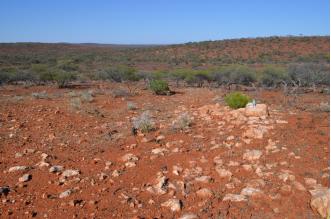
Noongall Station
The Noongall Station Homestead has historic significance for its long association with the pioneer Rodan and Morrissey families and the development of the pastoral industry in the Yalgoo district.
The Complex of buildings has further historic significance for its link with the gold mining town of Noongall which was established in 1896.
In the 1890s Charles Rodan acquired a number of leases in the vicinity of the Noongall townsite which he brought together to form Noongall Station. Rodan, who lived in the town of Noongall where he also owned the hotel, had several teams which carted goods to the Yalgoo district prior to the construction of the railway.
He and his family moved out to the station in 1913 and lived in the older of the two houses on the property, thought to have been built before 1910.
In the early 1920s Rodan's son James had the present
had the present
house built by H.C. Jermy, a well known builder in the
Yalgoo district. It is believed that Monsignor John Hawes
may have designed the house. Noongall was sold to the Morrissey's in 1930.
The built fabric illustrates developments through time
with variations in style and use of local materials
reflecting the requirements of the owners and workers.
Noongall Station has both aesthetic and rarity value
for the hand painted pressed metal ceilings by H.C.
Jermy, which are also a feature of the Carlaminda Station
The Basin - Noongall Station
Homestead and Melangata Station Homestead.
The Noongall Station Homestead Complex consists of the house, the original house, stables, kitchen, workers' and shearers' quarters and shearing shed.
The current homestead, The house, built c1910, which is in poor condition, is a large stone building with original wide, surrounding verandah which is enclosed at one end. Additional rooms to the rear of corrugated iron construction were demolished in the 1940s and reused on the current homestead for the bedroom additions.
Corrugated iron roof sheeting joins the main house to two separate buildings immediately to the north which include the kitchen, bedrooms and school room. The schoolroom was originally the kitchen which was transformed into the formal dining room in the 1950s.
The roof form is a combination of hips and gables. The external stonework features black pointing while the internal walls are lathe and plaster with ceiling roses and timber floors throughout.
Adjacent to the house stands the Meat House and the Bathroom/Laundry block which features a hand painted ceiling rose.
The outbuildings consist of a large timber framed corrugated iron clad shearing shed with substantial yards, stables of stone and mud construction with a corrugated iron roof (c 1890s), and a corrugated iron clad Blacksmith's Shop.
The original section of the Shearers' Quarters has stone walls which have since had corrugated iron additions and a corrugated iron hipped roof. Tree branches have been used for verandah posts, the verandah running the full length of the building. The Kitchen/Dining Room is a corrugated iron clad building which features a breezeway between the two rooms. A second Meat House stands adjacent.
